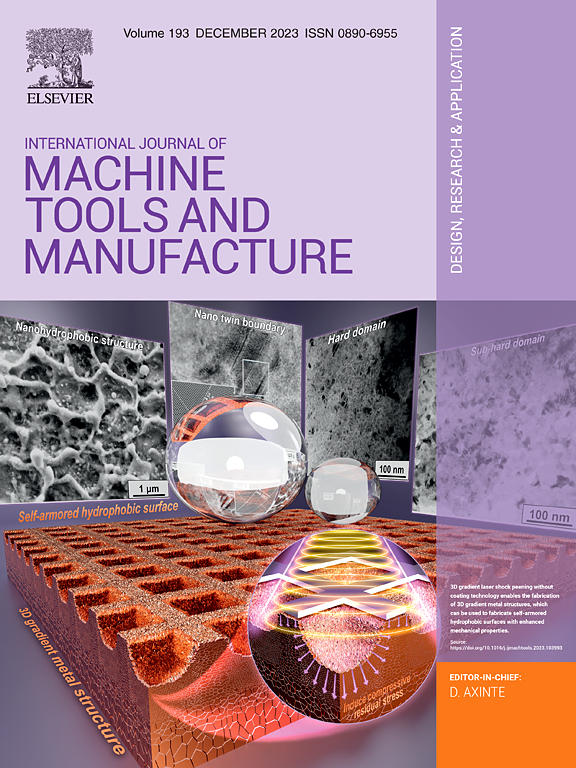钢搅拌摩擦焊中塑性流动的准原位重构及调节机理
IF 18.8
1区 工程技术
Q1 ENGINEERING, MANUFACTURING
International Journal of Machine Tools & Manufacture
Pub Date : 2025-10-07
DOI:10.1016/j.ijmachtools.2025.104341
引用次数: 0
摘要
解决钢搅拌摩擦焊接过程中塑性流动的问题是工艺的关键。然而,由于流场技术的局限性和对基础物理的理解不足,对塑性流动及其调节机制的整体理解在很大程度上仍然是经验主义的。在本研究中,通过准连续观测技术重建了材料对FSW刀具机械加工的响应。分析了型腔充填机理、刀工接触状态有效范围以及剪切层的实时边界。在更细的尺度上,多个独立的垂直分量被识别出来,引起不稳定的周期性流动或质量平衡效应。这些部件的特点是涡结构。据此,提出了一个动力学模型来具体解释局部涡旋结构的形成。该模型使用工具-工件相互作用作为定性描述的基础,以评估涡激活的位置,这一过程可以通过有限元模拟半定量地表示。涡旋的动态演化归因于固体边界对流场的约束作用。剪切层的实时边界被认为是固态边界的一种形式,其约束作用促进了局域涡旋的形成。具体地说,捕获涡的形成是基于刀具-工件相互作用的假设和剪切层边界的描绘来定义的。初步验证了模型的适应性,提出了一种低成本捕获先前隐藏的塑性流的方法。在广泛的工艺参数范围内,该模型有效地解释了塑性流动行为。这些分析不仅促进了对钢搅拌搅拌中流动动力学和相关剪切行为的全面了解,而且还证明了所提出的动态模型加深了对过程中复杂物理机制的基本理解。因此,该研究为优化焊接参数奠定了基础,并为未来专注于塑性流动或剪切行为控制的学术研究提供了支持。本文章由计算机程序翻译,如有差异,请以英文原文为准。

Quasi-in-situ reconstruction and regulating mechanism of plastic flow in steel friction stir welding
Resolving the mystery of plastic flow in steel friction stir welding (FSW) is critical for process. However, constrained by limitations in flow field techniques and insufficient understanding of the underlying physics, a holistic understanding of plastic flow and its regulating mechanism remains largely empirical. In this study, the material response to the mechanical processing of the FSW tool is reconstructed through a quasi-continuous observation technique. The mechanism of cavity filling, the effective range of tool-workpiece contact states, and the real-time boundary of the shear layer are analyzed. At finer scales, multiple independent vertical components are identified, inducing either unstable periodic flow or mass-balancing effects. These components are characterised as vortex structures. Accordingly, a dynamic model is proposed to specifically elucidate the formation of local vortex structures. The model uses tool–workpiece interaction as the basis for a qualitative description to assess the location of vortex activation, a process that can be semi-quantitatively represented through finite element simulations. The dynamic evolution of the vortex is attributed to the constraining effect of solid-state boundaries on the flow field. The real-time boundary of the shear layer is considered as one form of solid-state boundary, whose constraining effect promotes localised vortex formation. Specifically, the formation of captured vortexes is defined based on the assumption of tool-workpiece interaction and the delineation of shear layer boundaries. Model adaptability is preliminarily verified, and a low-cost method is proposed for capturing previously hidden plastic flows. Across a wide range of process parameters, this model effectively explains plastic flow behaviour. These analyses not only advance a comprehensive knowledge of flow dynamics and associated shear behaviour in steel FSW, but also demonstrate that the proposed dynamic model deepens the fundamental understanding of the complex physical mechanisms during the process. Therefore, this study lays a foundation for optimising welding parameters and supports future academic investigations focused on plastic flow or shear behaviour control.
求助全文
通过发布文献求助,成功后即可免费获取论文全文。
去求助
来源期刊
CiteScore
25.70
自引率
10.00%
发文量
66
审稿时长
18 days
期刊介绍:
The International Journal of Machine Tools and Manufacture is dedicated to advancing scientific comprehension of the fundamental mechanics involved in processes and machines utilized in the manufacturing of engineering components. While the primary focus is on metals, the journal also explores applications in composites, ceramics, and other structural or functional materials. The coverage includes a diverse range of topics:
- Essential mechanics of processes involving material removal, accretion, and deformation, encompassing solid, semi-solid, or particulate forms.
- Significant scientific advancements in existing or new processes and machines.
- In-depth characterization of workpiece materials (structure/surfaces) through advanced techniques (e.g., SEM, EDS, TEM, EBSD, AES, Raman spectroscopy) to unveil new phenomenological aspects governing manufacturing processes.
- Tool design, utilization, and comprehensive studies of failure mechanisms.
- Innovative concepts of machine tools, fixtures, and tool holders supported by modeling and demonstrations relevant to manufacturing processes within the journal's scope.
- Novel scientific contributions exploring interactions between the machine tool, control system, software design, and processes.
- Studies elucidating specific mechanisms governing niche processes (e.g., ultra-high precision, nano/atomic level manufacturing with either mechanical or non-mechanical "tools").
- Innovative approaches, underpinned by thorough scientific analysis, addressing emerging or breakthrough processes (e.g., bio-inspired manufacturing) and/or applications (e.g., ultra-high precision optics).

 求助内容:
求助内容: 应助结果提醒方式:
应助结果提醒方式:


